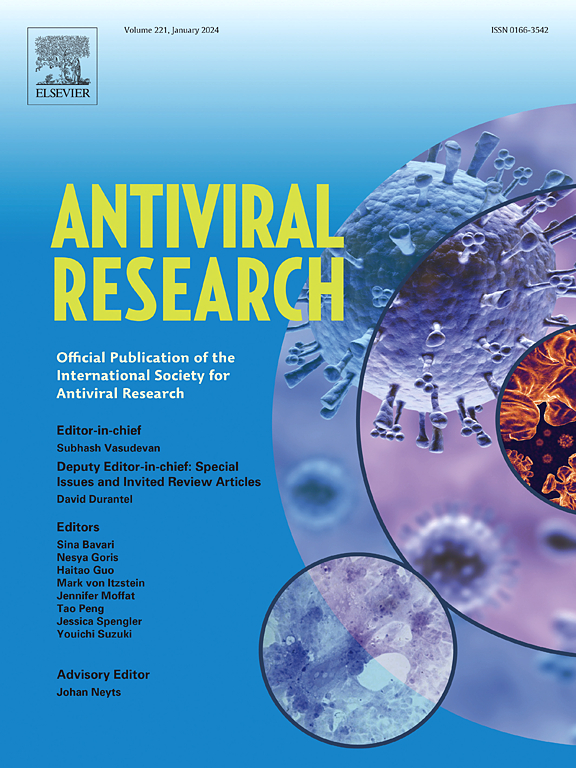Molecular analysis of the 2022 mpox outbreak and antiviral activity of dihydroorotate dehydrogenase inhibitors against orthopoxviruses
IF 4.5
2区 医学
Q1 PHARMACOLOGY & PHARMACY
引用次数: 0
Abstract
Monkeypox virus (MPXV) has caused a large pandemic outbreak in 2022 with more than 90.000 confirmed cases and 181 deaths. Notably, signs of microevolution and host adaption have been observed. Here, we demonstrate that viral genomes from Franconia, Bavaria acquired different mutations. Three isolates obtained from diagnostic samples, submitted from suspected Mpox cases, show differences in their replication capacities. One MPXV isolate which shows the fastest replication kinetics and higher viral loads, possesses a unique non-synonymous mutation (D616L) in the A11L protein (gene OPG136), which encodes for a protein that is part of a major viral core structure. In regard to pandemic preparedness and future outbreaks, we analyzed the antiviral activity of dihydroorotate dehydrogenase (DHODH) inhibitors, and show that they are active against MPXV, vaccinia virus (VACV), and cowpox virus (CPXV) and therefore likely against orthopoxviruses in general. In agreement with that, we also demonstrated that chemical optimization leads to compounds with EC50 values in the sub-nanomolar range, associated with low cytotoxicity, which forms a good basis for future drug development from this chemical series.
2022年麻疹暴发的分子分析及二氢酸脱氢酶抑制剂对正痘病毒的抗病毒活性。
猴痘病毒(MPXV)在2022年造成了大流行疫情,有9万多例确诊病例和181例死亡。值得注意的是,已经观察到微进化和宿主适应的迹象。在这里,我们证明了来自巴伐利亚州Franconia的病毒基因组获得了不同的突变。从疑似m痘病例提交的诊断样本中获得的三株分离株显示出其复制能力的差异。一种MPXV分离物显示出最快的复制动力学和更高的病毒载量,在A11L蛋白(基因OPG136)中具有独特的非同义突变(D616L),该突变编码一种主要病毒核心结构的蛋白质。关于大流行的准备和未来的爆发,我们分析了二氢羟酸脱氢酶(DHODH)抑制剂的抗病毒活性,并表明它们对MPXV、痘苗病毒(VACV)和牛痘病毒(CPXV)有活性,因此可能对一般的正痘病毒有活性。与此一致,我们还证明了化学优化导致化合物的EC50值在亚纳摩尔范围内,与低细胞毒性相关,这为该化学系列的未来药物开发奠定了良好的基础。
本文章由计算机程序翻译,如有差异,请以英文原文为准。
求助全文
约1分钟内获得全文
求助全文
来源期刊

Antiviral research
医学-病毒学
CiteScore
17.10
自引率
3.90%
发文量
157
审稿时长
34 days
期刊介绍:
Antiviral Research is a journal that focuses on various aspects of controlling viral infections in both humans and animals. It is a platform for publishing research reports, short communications, review articles, and commentaries. The journal covers a wide range of topics including antiviral drugs, antibodies, and host-response modifiers. These topics encompass their synthesis, in vitro and in vivo testing, as well as mechanisms of action. Additionally, the journal also publishes studies on the development of new or improved vaccines against viral infections in humans. It delves into assessing the safety of drugs and vaccines, tracking the evolution of drug or vaccine-resistant viruses, and developing effective countermeasures. Another area of interest includes the identification and validation of new drug targets. The journal further explores laboratory animal models of viral diseases, investigates the pathogenesis of viral diseases, and examines the mechanisms by which viruses avoid host immune responses.
 求助内容:
求助内容: 应助结果提醒方式:
应助结果提醒方式:


